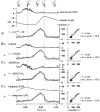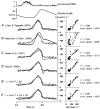Models of ensemble firing of muscle spindle afferents recorded during normal locomotion in cats
- PMID: 9490851
- PMCID: PMC2230775
- DOI: 10.1111/j.1469-7793.1998.277bu.x
Models of ensemble firing of muscle spindle afferents recorded during normal locomotion in cats
Abstract
1. The aim of this work was to compare the ability of several mathematical models to predict the firing characteristics of muscle spindle primary afferents recorded chronically during normal stepping in cats. 2. Ensemble firing profiles of nine hamstring spindle primary (presumed group Ia) afferents were compiled from stored data from 132 step cycles. Three sets of profiles corresponding to slow, medium and fast steps were generated by averaging groups of step cycles aligned to peak muscle length in each cycle. 3. Five models obtained from the literature were compared. Each of these models was used to predict the spindle firing profiles from the averaged muscle length signals. The models were also used in the reverse direction, namely to predict muscle length from the firing profiles. A sixth model incorporating some key aspects of the other models was also included in the comparisons. 4. Five of the models predicted spindle firing well, with root mean square (r.m.s.) errors lower than 14 % of the modulation depth of the target profiles. The key variable in achieving good predictions was muscle velocity, the best fits being obtained with power-law functions of velocity, with an exponent of 0.5 or 0.6 (i.e. spindle firing rate is approximately proportional to the square root of muscle velocity). The fits were slightly improved by adding small components of EMG signal to mimic fusimotor action linked to muscle activation. The modest relative size of EMG-linked fusimotor action may be related to the fact that hamstring muscles are not strongly recruited in stepping. 5. Length was predicted very accurately from firing profiles with the inverse of the above models, indicating that the nervous system could in principle process spindle firing in a relatively simple way to give accurate information on muscle length. 6. The responses of the models to standard ramp-and-hold displacements at 10 mm s-1 were also studied (i.e. velocities that were an order of magnitude lower than that during stepping). In these cases components of spindle primary response related to length as well as velocity were needed for good fits. Because these length-related components detracted from rather than improved predictions of the step cycle data, an attenuation of length dependence at high muscle velocities emerged as a possibility. 7. We conclude that in this study we have identified models and parameters that may be used to predict spindle afferent firing from the time course of muscle length in the cat step cycle.
Figures








References
-
- Al-Falahe NA, Nagaoka M, Vallbo AB. Response profiles of human muscle afferents during active finger movements. Brain. 1990;113:325–346. - PubMed
-
- Brown MC, Lawrence DG, Matthews PBC. Static fusimotor fibres and the position sensitivity of muscle spindle receptors. Brain Research. 1969;14:173–187. - PubMed
Publication types
MeSH terms
LinkOut - more resources
Full Text Sources
Other Literature Sources
Miscellaneous

